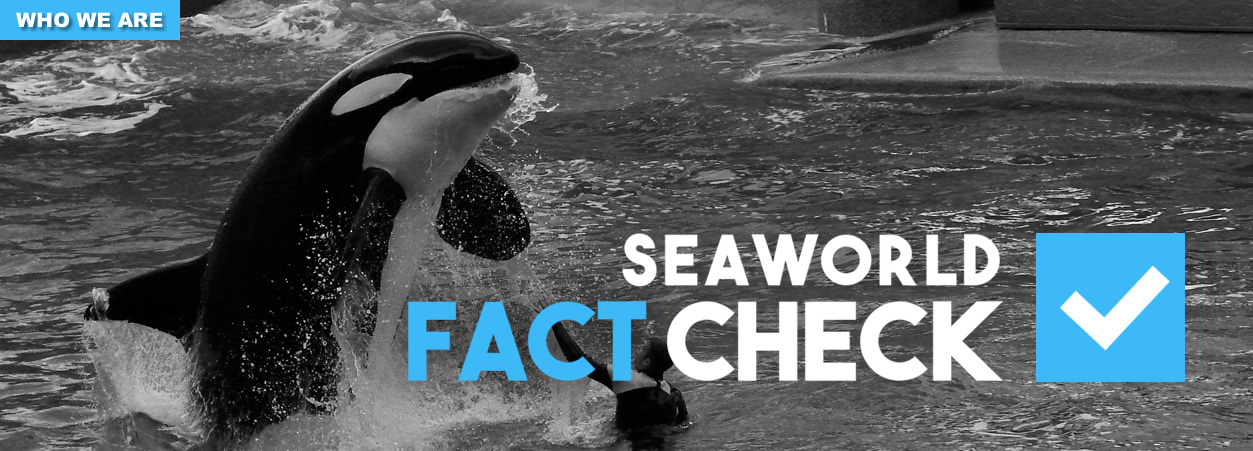SEAWORLD FACT CHECK:
The small blue box in the upper middle of this picture shows the total amount of space in the largest orca tank at SeaWorld. The yellow line shows the path of a dive by a free-ranging orca from the southern resident population, K33.
 |
Figure 1. Graphic comparing SeaWorld tank size to one dive by a free-ranging orca.
SOURCE: Whiting 2015 |
|
|
|
SeaWorld tanks, even the proposed Blue World expansion, are a minute fraction the size of the smallest known orca natural habitat (Baird 2000). Yet room to swim and dive are only part of why orca natural habitat cannot be duplicated in captivity. For example, SeaWorld tanks are filled with clear, treated water, with walls painted reflective colors (light blue or white), to allow good visibility at underwater viewing windows. The ocean has variable visibility and depths (e.g., turbid or deep water, where visibility is poor or zero and hearing and echolocation become more important than vision), many other animal species, diverse vegetation, variable bottom contours, different substrates (e.g., rock, sand, mud) and so on.
Whales are adapted to live in this complex, dynamic, sensory-rich environment. Figure 2a shows how the salinity of the Salish Sea (inhabited by the southern resident orcas) varies over the course of a single day, and Figure 2b shows what happens as salty ocean water meets freshwater from rivers.
 |
Figure 2. a) Salish Sea salinity b) Puget Sound salinity. The frames are every hour for one day.
SOURCE: UW Coastal Modeling Group 2015 |
|
|
Sound, which is essential to whales for locating food, staying together, and avoiding predators, travels through seawater and freshwater at different speeds. As whales descend through these water layers, their bodies also must adjust to pressure changes. Their lungs collapse and their heart rates slow to 10 beats per minute or less…yet they still communicate and search for food (Kooyman 2009).
 |
Figure 3. Sound velocity (m/s) vs. depth (m) and latitude (S) derived from temperature, salinity and depth measurements, for the first 500 m of the water column in Drake Passage.
SOURCE: Baqués and Blanc 2004 |
|
|
So as orcas move as much as 100 linear miles (and dive up to 850 feet in depth) during a day, they experience constant changes in how fresh, salty, warm, cold, light, and deep the water is. The currents and tides are in constant flux, and can completely change direction with depth. No artificial, concrete enclosure in the world recreates this complexity in any approximation.
 |
Figure 4. Distance K33 traveled in 6+ hours. The largest SeaWorld orca enclosure is about the size of one dot on this track.
SOURCE: Cascadia Research
2010
|
|
|
References:
Baird, R.W. 2000. The killer whale. pp. 127-153. In: J. Mann, R.C. Connor, P.L. Tyack, and H. Whitehead (eds.) Cetacean Societies, University of Chicago Press: Chicago. 433 pp.
Baqués, M. and Blanc, S. 2004. Oceanographic and acoustic measurements in Drake Passage. Gayana 68 (suppl.): 22-28.
Cascadia Research. 2010. http://www.cascadiaresearch.org/kws/dtagging.htm
Kooyman, G. 2009. Diving physiology. pp. 327-332. In: W.F. Perrin, B. Wursig, and J.K. Thewissen (eds.) Encyclopedia of Marine Mammals (2nd edition), Academic Press: New York, NY. 1316 pp.
UW Coastal Modeling Group. 2015. http://faculty.washington.edu/pmacc/cmg/cmg.html.
Whiting, C. 2015. SeaWorld Tanks – Why Bigger Will Never Be Big Enough. Seattle Post-Intelligencer blog, April 23, 2015.
_____________
SEAWORLD SAYS:
Our killer whale habitats are among the largest in the world today. They are multi-million-gallon environments of continually chilled and filtered saltwater. In fact, SeaWorld Orlando’s habitat is 36 feet deep and holds more than 6 million gallons!
We even have a dedicated team of water quality experts on call 24/7 to monitor and ensure all water quality conditions meet or exceed federal standards.
And, our habitats are about to get even bigger.
|

